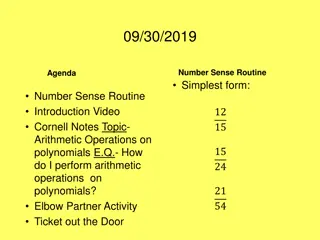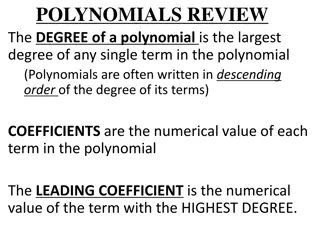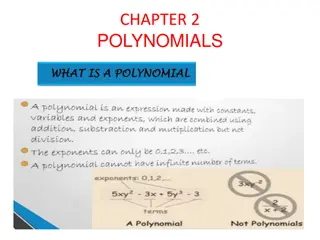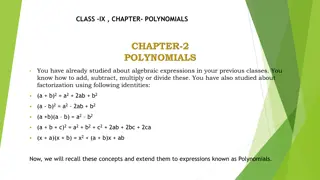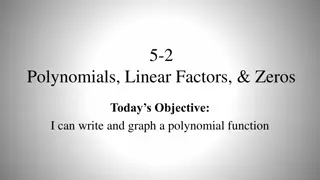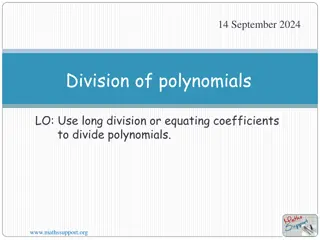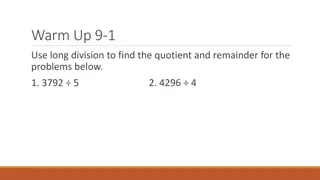
Understanding Polynomials: Basics and Degrees
Dive into the fundamentals of polynomials, including constants, variables, terms, and degrees. Learn to identify and work with polynomials in one variable and explore how to determine the degree of a polynomial equation. Enhance your knowledge of algebraic expressions and their components.
Download Presentation

Please find below an Image/Link to download the presentation.
The content on the website is provided AS IS for your information and personal use only. It may not be sold, licensed, or shared on other websites without obtaining consent from the author. If you encounter any issues during the download, it is possible that the publisher has removed the file from their server.
You are allowed to download the files provided on this website for personal or commercial use, subject to the condition that they are used lawfully. All files are the property of their respective owners.
The content on the website is provided AS IS for your information and personal use only. It may not be sold, licensed, or shared on other websites without obtaining consent from the author.
E N D
Presentation Transcript
POLYNOMIALS Grade 9 Chapter 2
Introduction Constants : A symbol having a fixed numerical value is called a constant. Variables : A symbol which may be assigned different numerical values is known as variable. Algebraic expressions : A combination of constants and variables connected by some or all of the operations +, -, *,/ is known as algebraic expression. Terms : The several parts of an algebraic expression separated by + or - operations are called the terms of the expression.
Polynomial Polynomial is an algebraic expression which includes constants, variables and exponents. It is the expression in which the variables have only positive integral powers. Example 1. 4x3+ 3x2+ x +3 is a polynomial in variable x. 2. 4x2+ 3x-1- 4 is not a polynomial as it has negative power. 3. 3x3/2+ 2x 3 is not a polynomial.
Polynomials in One Variable Polynomials in One Variable If there is only one variable in the expression then this is called the polynomial in one variable. Example x3+ x 4 is polynomial in variable x and is denoted by p(x). r2+ 2 is polynomial in variable r and is denoted by p(r).
What is the Degree of a Polynomial? A polynomial s degree is the highest or the greatest degree of a variable in a polynomial equation. The degree indicates the highest exponential power in the polynomial (ignoring the coefficients). For Example: 6x4+ 2x3+ 3 The degree of the polynomial 6x4+ 2x3+ 3 is 4. Let s take another example: 3x8+ 4x3+ 9x + 1 The degree of the polynomial 3x8+ 4x3+ 9x + 1 is 8.
(a) In one variable: In case of a polynomial in one variable, the highest power of the variable is called the degree of the polynomial. e.g., 2 y3+ y5+ 2y6is a polynomial in y of degree 6. 6x + 3 is a polynomial in x of degree 1. (b) In two or more variables: In case of a polynomial in more than one variable, the sum of the powers of the variables in each term is taken up and the highest sum so obtained is called the degree of the polynomial. e.g., 3x3 7x2y2+ 8 is a polynomial in x and y of degree 4. 8a8b 4ab + 2 is a polynomial in a and b of degree 9.
Note: The degree of a non-zero constant polynomial is zero . The degree of a zero polynomial is not defined.
Types of Polynomial Monomial: Polynomials having only one term are called monomials ( mono means one ). e.g., 43, xz and 2 are all monomials. Binomial: Polynomials having only two terms are called binomials ( bi means two ). e.g., (x2+ x), (y30+ 2) and (5x2y + 6xz) are all binomials. Trinomial: Polynomials having only three terms are called trinomials ( tri means three ). e.g., (x4+ x3+ 2), ( 43+ 7+ ) and (8y 5xy + 9xy2) are all trinomials.
Constant polynomial: A polynomial containing one term only, consisting of a constant is called a constant polynomial. e.g., -6, 4,, etc., are still constant polynomial. Generally, each real number is a constant polynomial. Zero polynomial: A polynomial consisting of one term, namely zero only, is called a zero polynomial
Linear Polynomial: A polynomial of degree one is called a linear polynomial. e.g., x + 7 is a linear polynomial in x, y and z. 2 + 3 is a linear polynomial in . Quadratic Polynomial: A polynomial of degree two is called a quadratic polynomial. e.g; xy + yz + zx is a quadratic polynomial in x, y and z. x2+ 9x is a quadratic polynomial in x. Cubic Polynomial: A polynomial of degree three is called a cubic polynomial. e.g., ax3+ bx2+ cx + d is a cubic polynomial in x and a, b, c, d are constants. 2y3+ 3 is a cubic polynomial in y. 9x2y + xy 4 is a cubic polynomial in x and y.
For each of the following polynomials write down its degree: (i) 1 + 3z (ii) 1 + 3m + 5m2 (iii) 4u + 5u3+ 17u5+ 7 (iv) a9+ 4a3+ 7a2+ 10 (v) -11p + 7 (vi) m6+ 1 (vii) 2a2+ 3a2+ 4a (viii) 5a3b 7a2+ 11b2 (ix) 0 (x) 536



